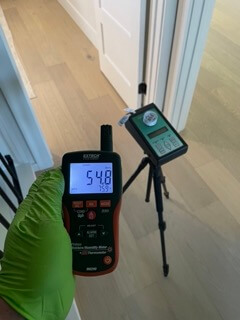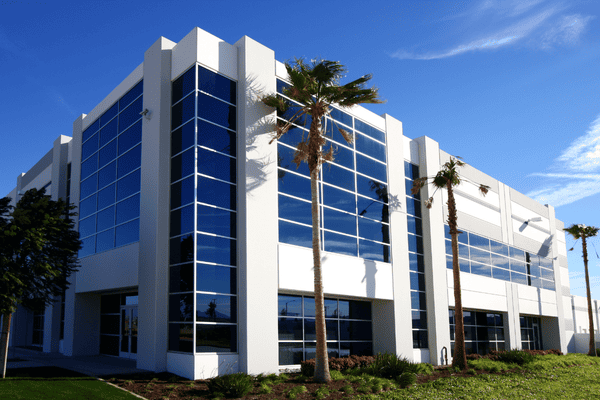Mold doesn’t knock before it moves in. It creeps into damp spaces, hides behind walls, and silently spreads through your building. Before you know it, tenants are coughing, walls are warping, and an inspector is handing you a health violation notice.
Commercial building mold testing helps identify and address mold problems early, protecting your investment, tenants, and employees. Left untreated, mold can spread quickly, causing allergic reactions, respiratory issues, and even legal concerns. Regular mold detection and prompt remediation are key to maintaining a safe and compliant indoor environment.
In this guide, we’ll explore why mold is a serious concern, how to recognize the warning signs, and when to test for mold in a commercial building. We’ll also walk you through the testing process, help you understand acceptable levels of mold in buildings, and provide strategies for prevention.
Where Mold Hides in Commercial Buildings (And Why It’s a Bigger Risk Than You Think)
Mold isn’t just a problem in abandoned buildings—it thrives in commercial spaces, often where you least expect it. Here’s where it hides and why your building could be at risk:
- Restrooms & Breakrooms – Frequent spills and steam create a breeding ground for mold.
- Storage Areas & Warehouses – Poor ventilation means trapped moisture can fuel hidden mold growth.
- HVAC Systems – Mold spores love to hitch a ride on shared ventilation, spreading through an entire building.
- Under Carpets & Ceiling Tiles – Leaks and humidity get trapped, leading to mold growth where you least expect it.
Ignoring mold in a commercial setting isn’t just a minor inconvenience—it can lead to costly damage, failed health inspections, and legal headaches. Regular mold testing is key to protecting your property and the people inside it.
Warning Signs: How to Detect Mold in a Commercial Building

Recognizing mold early can save you thousands in repairs and keep occupants safe. Here are some key indicators that mold might be present in your building:
- Visible mold growth: Mold appears as discolored spots (black, green, or white) on walls, ceilings, and HVAC vents.
- Persistent musty odors: A stale, mildew-like smell often points to hidden mold behind walls or under carpets.
- Increased respiratory issues: Chronic coughing, sneezing, watery eyes, and allergic reactions among employees may indicate air quality issues caused by mold.
- Water damage: Peeling paint, warped flooring, discolored ceilings, and persistent leaks set the stage for mold proliferation.
If you notice these signs, don’t ignore them. Mold spreads fast, and waiting can mean bigger costs and bigger problems. Call a mold testing professional ASAP to assess the risk before it escalates.
When Should You Get Commercial Building Mold Testing?
Many property owners wait until there’s a visible mold issue, but regular mold detection is essential. Here are critical situations when mold testing is necessary:
- After Flooding or Leaks – Mold can start growing within 24-48 hours after water exposure.
- Before Lease Renewal or Buying a Property – Avoid taking on an expensive mold problem.
- If Employees or Tenants Complain About Air Quality – Recurring respiratory issues? Mold could be the culprit.
- Before Renovations – Construction can stir up hidden mold spores, making problems worse.
- As Part of Annual Maintenance – Stay ahead of potential mold issues before they impact your property.
Austin mold testing experts like Howard Environmental conduct thorough assessments to provide accurate data on mold presence and air quality levels.
Understanding the Professional Mold Testing Process

Expect a multi-step process when hiring a mold testing professional. Reputable experts follow these steps to ensure accurate results:
Step 1: On-Site Assessment
A certified inspector will examine moisture-prone areas, check ventilation, and identify obvious mold growth.
Step 2: Sample Collection
- Air sampling: Captures airborne mold spores.
- Surface testing: Collects mold samples from walls, floors, and furniture.
- Materials analysis: Identifies mold presence in drywall, wood, and insulation.
- Infrared moisture mapping: Detects leaks and hidden moisture pockets.
Step 3: Lab Testing & Analysis
Samples are tested to determine the mold type and its severity.
Step 4: Results & Recommendations
You’ll receive a full report that outlines whether mold levels exceed acceptable limits and what to do next.
Preventing Mold Growth in Commercial Properties
Prevention should always be a priority. Here are effective ways to reduce mold risks:
- Maintain humidity levels below 60% with dehumidifiers and air conditioners.
- Improve ventilation, especially in storage rooms and basements.
- Address leaks in roofs, plumbing, and HVAC systems promptly.
- Schedule periodic professional mold inspection and remediation services.
Is Mold in a Building an OSHA Violation?
One common concern for business owners is whether mold problems can result in legal consequences. The answer? Yes, in some cases.
The Occupational Safety and Health Administration (OSHA) does not have a specific mold standard, but employers are required to provide a safe work environment. If mold exposure leads to serious health issues among employees, it can violate regulations under the General Duty Clause.
Routine commercial building mold testing and proactive remediation not only protect tenants and employees but also keep businesses compliant with health and safety requirements.
Mold Testing vs. Mold Remediation: What’s the Difference?
Property owners often confuse mold testing with remediation, but they serve different purposes:
- Mold testing: Confirms mold presence, identifies spores, and measures contamination levels.
- Remediation: Involves removal, cleaning, and treatment of affected areas to prevent recurrence.
Skipping testing before remediation can be a costly mistake. Testing validates the extent of the issue and determines the right course of action.
Proactive Mold Testing for a Safe Work Environment
Regular commercial mold testing is vital for maintaining healthy workspaces, complying with safety regulations, and protecting property value. Mold growth left unaddressed can lead to costly repairs, legal liabilities, and health risks for occupants.
Don’t wait for a problem to escalate—contact Howard Environmental today for a comprehensive mold inspection and testing service and take a proactive step in mold management.

